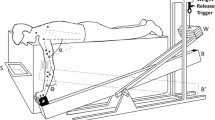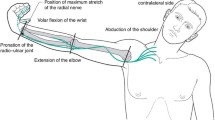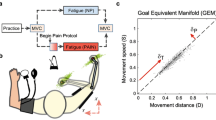Abstract
This study assessed interactions between mild/moderate muscle pain and inertial load on the control of human elbow-flexion movements. It is hypothesized that high inertial load combined with moderate muscle pain intensity affect the motor control more than for low inertial-load combined with low-intensity pain. Fifteen subjects performed horizontal pointing movements (70° range) under three load conditions: 0, 4, and 10 kg. Pain was induced by injection of 0.5 ml and 1.5 ml hypertonic saline into the biceps muscle. Subjects scored the muscle pain intensity on a visual analogue scale (VAS). Elbow joint position, VAS, and the electromyograms (EMG, m. biceps brachii, m. triceps brachii, m. brachioradialis, and m. trapezius) were recorded. Mild and moderate muscle pain attenuated acceleration profiles [6.1(0.9)%], effective movement amplitude [3.2 (0.7)%], peak velocity [5.8 (0.9)%] and prolonged the reaction time [21 (5)%]. No interaction between muscle pain intensity and inertial load was found for the kinematic parameters. EMG profiles from m. biceps brachii, m. triceps brachii, and m. brachioradialis were similarly attenuated [10.2 (0.80)%] by mild and moderate muscle pain in all inertial load conditions. For high inertial load, the initial agonist EMG burst activity was more attenuated [50 (5.3)%] by moderate muscle pain compared with mild muscle pain [34 (4.2)%]. These data suggest that for high effort-demanding tasks muscle pain differently affects the motor planning according to the pain-intensity level. Perturbations of motor planning lead to changes on movement strategies, which might be a potential cause of musculoskeletal problems.




Similar content being viewed by others
References
Ahern DK, Follick MJ, Council JR, Laser-Wloston N, Litchman H (1988) Comparison of lumbar paravertebral EMG patterns in chronic low back pain patients and non-patient controls. Pain 34:153–160
Arendt-Nielsen L, Graven-Nielsen T, Svanner H, Svensson P (1996) The influence of low back pain on muscle activity and coordination during gait: A clinical and experimental study. Pain 64:231–240
Ashton-Miller JA, McGlashen KM, Herzenberg JE, Stohler CS (1990) Cervical muscle myoelectric response to acute experimental sternocleidomastoid pain. Spine 15:1006–1012
Birch L, Graven-Nielsen T, Christensen H, Arendt-Nielsen L (2000) Experimental muscle pain modulates muscle activity and work performance differently during high and low precision use of a computer mouse. Eur J Appl Physiol 83:492–498
Ciubotariu A, Arendt-Nielsen L, Graven-Nielsen T (2004) The influence of muscle pain and fatigue on the activity of synergistic muscles of the leg. Eur J Appl Physiol (in press)
Corcos DM, Gottlieb GL, Gyan CA (1989) Organizing principles for single-joint movements II. A speed-sensitive strategy. J Neurophysiol 62:358–368
Dickstein R, Hocherman S, Amdor G, Pillar T, Winstein CJ, Pohl PS, Wolf SL (1993) Reaction and movement times in patients with hemiparesis for unilateral and bilateral elbow flexion. Phys Ther 73:374–385
Ervilha UF, Arendt-Nielsen L, Duarte M, Graven-Nielsen T (2004) The effect of muscle pain on elbow flexion and co-activation tasks. Exp Brain Res (in press)
Farina D, Arendt-Nielsen L, Merletti R, Graven-Nielsen T (2004) The effect of experimental muscle pain on motor unit firing rate and conduction velocity. J Neurophysiol 91:1250–1259
Gottlieb GL (1998) Muscle activation patterns during two types of voluntary single-joint movement. J Neurophysiol 80:1860–1867
Gottlieb GL, Corcos DM, Agarwal GC (1989) Strategies for the control of voluntary movements with one mechanical degree of freedom. Behav Brain Sci 12:189–210
Graven-Nielsen T, Svensson P, Arendt-Nielsen L (1997) Effects of experimental muscle pain on muscle activity and co-ordination during static and dynamic motor function. Electroencephalogr Clin Neurophysiol 105:156–164
Hodges PW (2001) Changes in motor planning of feedforward postural responses of the trunk muscles in low back pain. Exp Brain Res 141:261–266
Howell JN, Chila AG, Ford G, David D, Gates T (1985) An electromyographic study of elbow motion during postexercise muscle soreness. J Appl Physiol 58:1713–1718
Khan MA, Garry MI, Franks IM (1999) The effect of target size and inertial load on the control of rapid aiming movements. Exp Brain Res 124:151–158
Kravitz E, Moore ME, Glaros A (1981) Paralumbar muscle activity in chronic low back pain. Arch Phys Med Rehabil 62:172–176
Larsson B, Bjork J, Elert J, Gerdle B (2000) Mechanical performance and electromyography during repeated maximal isokinetic shoulder forward flexions in female cleaners with and without myalgia of the trapezius muscle and in healthy controls. Eur J Appl Physiol 83:257–267
Lund JP, Donga R, Widmer CG, Stohler CS (1991) The pain-adaptation model: A discussion of the relationship between chronic musculoskeletal pain and motor activity. Can J Physiol Pharmacol 69:683–694
Luoto S, Taimela S, Alaranta H, Hurri H (1998) Psychomotor speed in chronic low-back pain patients and healthy controls: construct validity and clinical significance of the measure. Percept Mot Skills 87:1283–1296
Madeleine P, Lundager B, Voigt M, Arendt-Nielsen L (1999a) Shoulder muscle co-ordination during chronic and acute experimental neck-shoulder pain: An occupational pain study. Eur J Appl Physiol 79:127–140
Madeleine P, Voigt M, Arendt-Nielsen L (1999b) Reorganization of human step initiation during acute experimental muscle pain. Gait Posture 10:240–247
Nouwen A, Bush C (1984) The relationship between paraspinal EMG and chronic low back pain. Pain 20:109–123
Pfann KD, Hoffman DS, Gottlieb GL, Strick PL, Corcos DM (1998) Common principles underlying the control of rapid, single degree-of-freedom movements at different joints. Exp Brain Res 118:35–51
Radebold A, Cholewicki J, Panjabi MM, Patel TC (2000) Muscle response pattern to sudden trunk loading in healthy individuals and in patients with chronic low back pain. Spine 25:947–954
Radebold A, Cholewicki J, Polzhofer GK, Greene HS (2001) Impaired postural control of the lumbar spine is associated with delayed muscle response times in patients with chronic idiopathic low back pain. Spine 26:724–730
Robinson ME, Cassisi JE, O’Connor PD; MacMillan M (1992) Lumbar iEMG during isotonic exercise: chronic back pain patients versus controls. J Spinal Disord 5:8–15
Schmidt RA (1988) Information processing and memory systems. In: Motor control and learning: a behavioral emphasis. Human Kinetics, Champaign, Ill. pp 75–98
Schwartz G, Lund JP (1995) Modification of rhythmical jaw movements by noxious pressure applied to the periosteum of the zygoma in decerebrate rabbits. Pain 63:153–161
Svensson P, Houe L, Arendt-Nielsen L (1997) Bilateral experimental muscle pain changes electromyographic activity of human jaw-closing muscles during mastication. Exp Brain Res 116:182–185
Svensson P, Arendt-Nielsen L, Houe L (1998a) Muscle pain modulates mastication: an experimental study in humans. J Orofac Pain 12:7–16
Svensson P, Graven-Nielsen T, Matre D, Arendt-Nielsen L (1998b) Experimental muscle pain does not cause long-lasting increases in resting electromyographic activity. Muscle Nerve 21:1382–1389
Taimela S, Kujala UM (1992) Reaction times with reference to musculoskeletal complaints in adolescence. Percept Mot Skills 75:1075–1082
Travell J, Rinzler S, Herman M (1942) Pain and disability of the shoulder and arm. JAMA 120:417–422
Veiersted KB, Westgaard RH, Andersen P (1990) Pattern of muscle activity during stereotyped work and its relation to muscle pain. Int Arch Occup Environ Health 62:31–41
Vernazza-Martin S, Martin N, Cincera M, Pedotti A, Massion J (1999) Arm raising in humans under loaded vs. unloaded and bipedal vs. unipedal conditions. Brain Res 846:12–22
Weerakkody NS, Percival P, Canny BJ, Morgan DL, Proske U (2003) Force matching at the elbow joint is disturbed by muscle soreness. Somatosens Mot Res 20:27–32
Zedka M, Prochazka A, Knight B, Gillard D, Gauthier M (1999) Voluntary and reflex control of human back muscles during induced pain. J Physiol (Lond) 520:591–604
Acknowledgement
The Danish Technical Research Council has supported this work.
Author information
Authors and Affiliations
Corresponding author
Rights and permissions
About this article
Cite this article
Ervilha, U.F., Arendt-Nielsen, L., Duarte, M. et al. Effect of load level and muscle pain intensity on the motor control of elbow-flexion movements. Eur J Appl Physiol 92, 168–175 (2004). https://doi.org/10.1007/s00421-004-1083-8
Accepted:
Published:
Issue Date:
DOI: https://doi.org/10.1007/s00421-004-1083-8




